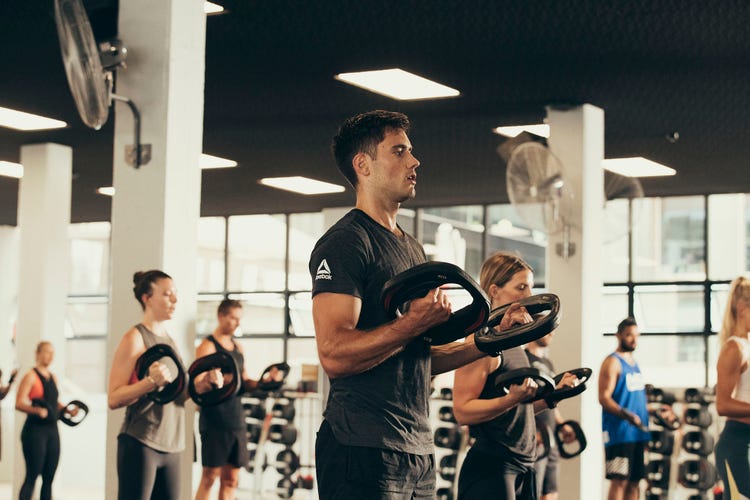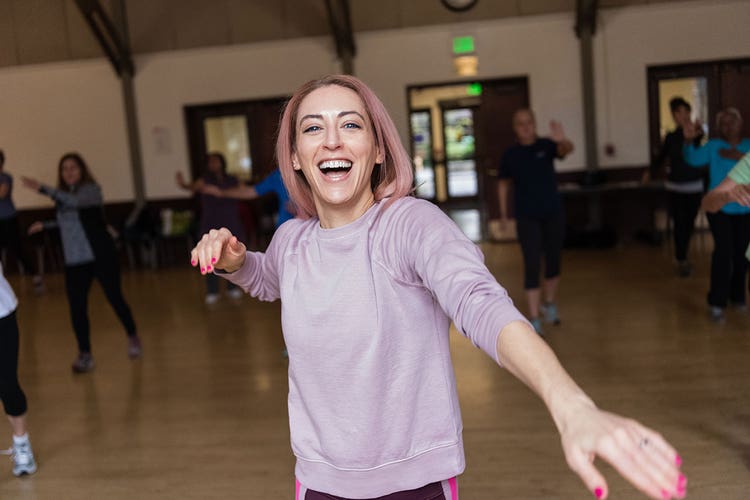Movement Helps People Come Together

Over the last five years, 24Life has conducted more than 2,500 interviews in the pursuit of our editorial mission—to help our readers discover and uncover what they need to move forward. While the answers are diverse and rich in variety, they are familiar and simple at the core—we feel better in our bodies and in our lives when we take time to lead our mindset, move more, sleep well, eat food that nourishes and move our bodies, regularly and in ways that we enjoy.
It is not surprising to learn that experts, authors celebrities, instructors, trainers, doctors, and everyday athletes, all agree that a commitment to regular movement and physical activity, is worth it. As we get stronger and improve overall health and fitness, we feel better and happier. They also attest to the transformational impact on life outside of the gym—when we find our fitness community, there is a profound and noticeable effect that permeates everything we do. When we take care of our own well being, we lift others and in doing so, reinforce transformational change in our own life.
Les Mills has dedicated research at the Les Mills Lab on this very effect—groupness. And Dr. Kelly McGonigal details her findings in her new book The Joy of Movement—and we love her concept of “collective joy.” Whether it is groupness you seek or collective joy that you find, we truly hope that this week you block time to tap into the tremendous life-altering power of fitness.
COLLECTIVE JOY (Dr. Kelly McGonigal)
“Collective joy,” says Dr. Kelly McGonigal, “is the idea of is that when we move together, particularly in synchrony with other people, it alters our mindset. It alters what’s happening in our brains in a way that allows us to experience ourselves as connected to something bigger than ourselves.
“Like the original idea from Émile Durkheim—a philosopher who talked about how we experience this in collective labor or when we’re in church doing a religious ritual—when we synchronize our behaviors together, we feel this kind of transcendence. Sometimes people talk about it only in terms of the endorphin rush you get. But you can get an endorphin rush from a lot of things. Part of it’s the endorphin rush, we know that when we move in synchrony with others, we do get an endorphin rush and it makes us feel good and helps us bond with others.
“There’s also something really interesting about how our perceptual system begins to make us literally expand our sense of self. So, if you were moving with other people, you feel like you are bigger, and your sense of self transcends the limits of your own body. It’s not like you just feel connected to other people, you feel like you and the others that you’re moving with are one. And you sense the energy and the possibility and that feeling of expansiveness that is the whole group moving. And that it’s a very—I think of it and the research suggests this is a psychological state that gives us tremendous hope.

“In my work on stress, I often talk about needing to have a bigger than self-mindset for dealing with really big stress—the kind of stress you can’t handle on your own, like grief or loss or trauma—big problems. And you can’t just sort of pull yourself up and fix it. You need to lean on others and lean on maybe a sense of—a connection to something bigger than yourself. Collective joy is the way that movement allows us to really experience that in our bodies: the sense that we aren’t alone, we don’t have to do it all ourselves and that we are part of something bigger than us. The emotional quality of it is this kind of hopefulness.
“Some psychologists have described it as we-agency, which is kind of a funny term, but we’re always like– instead of being just self-efficacy like, ‘I can do it,’ it’s a sense of, ‘We can do this and I don’t have to do it on my own.’ I think it’s why so many people turn to group fitness or group training, like a running group, when they’re going through something difficult in their lives. I don’t know that they would even be able to express it, but when you’re in that moment of moving together and you’re getting that endorphin rush and you’re feeling closer and connected to other people, you’re also tapping into this human capacity to sense our interdependence. And that can be a tremendous relief.”
GROUPNESS (Les Mills)
It’s been hailed as the answer to any number of ailments—heart disease, depression, and chronic back pain, to name a few. But could the fitness studio also be the antidote to a more modern phenomenon: technology-driven loneliness? As the proliferation of smartphones, social media and remote working continues to erode human touchpoints in our lives, particularly among younger generations, loneliness is becoming a major societal issue.
According to a 2018 survey from The Economist and the Kaiser Family Foundation (KFF), more than two in ten adults in the United States (22 percent) and the United Kingdom (23 percent) say they always or often feel lonely, lack companionship, or feel left out or isolated, with technology cited as a major contributor. However, fitness may hold the solution. New research suggests health clubs could have a major role to play in helping people to digitally disconnect and get back to their real-world roots by reaping the benefits of shared exercise experiences.
The group effect
Published this month in the Journal of Sport, Exercise and Performance Psychology, the Les Mills Groupness Study found that gym attendees experience increased levels of individual enjoyment, exertion, and satisfaction as a result of group exercise. It identified the powerful role ‘the group effect’ plays in positively influencing a club member’s overall workout experience—and their intention to return.
https://www.youtube.com/watch?v=nEjERfTum7c
“What our findings show is that we are social animals when it comes to working out,” says Les Mills Head of Research Bryce Hastings. “When you maximize the group effect, this leads to a high level of what we’ve termed ‘groupness’. And the higher the level of groupness, the more we see increases in a person’s enjoyment, satisfaction, and exertion.”
The “groupness” factor was also cited as an influence on member retention, chiming with previous research which has found group exercisers are 26 percent less likely to cancel memberships than gym-only members. Gym attendees experience increased levels of individual enjoyment, exertion, and satisfaction as a result of group exercise, new research has found

Instructors are essential
“We now also know that increased groupness is correlated with a stronger intention to return, which may affect adherence. In other words, it’s all-encompassing for the club member,” Hastings adds, noting that the group exercise instructor plays a crucial role in maximizing the group effect.
“Instructors are armed with the knowledge, skills, and experience to know how to help people feel like they’re working out as a true group with shared goals. “It’s their ability to connect with the individuals in the group and create a sense of ‘we’ in a class that produces a very positive overall experience. They take what we know from science and bring it to life for club members.”
The study saw 97 adult exercisers take part in a variety of different group fitness classes. These included cardiovascular athletic conditioning such as cycling (RPM™), martial arts-inspired workouts (BODYCOMBAT™), synchronized strength training using weights (BODYPUMP™), and high-intensity interval sessions (LES MILLS GRIT™ and LES MILLS SPRINT™).
Photo, video credit: Mark Kuroda, kurodastudios.com; Les Mills